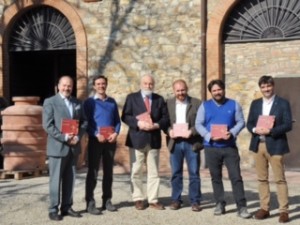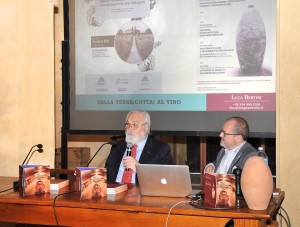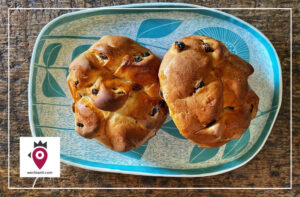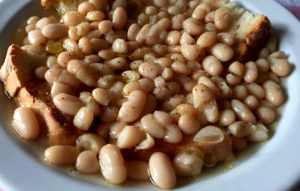Articolo disponibile anche in: Italian
“Dalla Terra(cotta) al vino”, is the title of a book by Emanuele Vescovo, the first in a series from the site, www.lepaginedelvino.it. It will soon be available in the digital version and will be presented in exclusive at the Fattoria Montecchio.
It tells the story of the winery, in the heart of Chianti Classico in San Donato in Poggio (Tavarnelle). Inside the estate there is an antique furnace, where for centuries the tradition of handmade terra-cotta, has been passed on by artisans.
In addition to garden and house ornaments, made from special galestro stone from the area, are also produced urns and amphors.
Here, four years ago, the Fattoria Montecchio decided to try and rediscover the antique technique of winemaking and aging in amphorae, adding it to the traditional barrique and barrel.
The result was Priscus, made from pure Sangiovese grapes with intense color and a very persistent structure and tannin which, not by chance, bears the name of a Roman gladiator.

“The project for winemaking and aging in amphora,” explains the owner of the Fattoria Montecchio, Riccardo Nuti, “was born within our company and experimented on our wine, Priscus. In fact, annexed to the winery is an antique furnace from the 1800s, opened by my father Ivo in the early 90s. It has always been a feather in the cap of our winery. Thanks to the wine cellar’s know how, united with terra-cotta, we were able to create a functional artifact for the wine making process with the collaboration of professor Ricci”.
It is an interesting story, one that characterizes the Fattoria Montecchio. The journalist and sommelier, Emanuele Vescovo, was fascinated by the story.
“I already was acquainted with the winery, Fattoria Montecchio, but it was during Vinitaly in 2016 that I was able to taste Priscus, the wine produced in amphora, but I was also able to compare the same vine from the same vintage, created in the traditional way as well as within the terra-cotta. How many producers have the possibility to create their own furnace for winemaking? This, therefore, is what is unusual about the Fattoria Montecchio; the production in amphorae and the possibility to experiment with their own grapes”.

Massimo Ricci, expert in restoration for Unesco and professor of Architectural Technology at the University of Florence, curated the realization of amphorae in various sizes and forms for the Fattoria Montecchio and the Antica Fornace Motecchio; amphorae which were useful in winemaking and for rendering the process similar to that of winemaking in barriques.
The rediscovery of the technologies of the past gave excellent results, also because it took advantage of the progress of modern times.
“We were able to produce,” adds Ricci, “a barrel of wine of circa 5000 liters, which provided all that was necessary for a modern process of winemaking. In addition, we discovered that wine within these materials maintain themselves in a perfect way and don’t change taste”.
It is useful for us today to begin with the history of winemaking and the use of materials like terra-cotta.“ The evolution of winemaking techniques,” explains the oenologist, Stefano Di Biasi, “regards the best use of terra-cotta and winemaking processes. By putting the various modalities in parallel, we were able to observe their interesting effect on the wine from both the sensorial and tasting points of view; it helps the stabilization of color and therefore the expression of the fruit, with a taste that isn’t contaminated by wood”.
“Over the years – conclude Di Biasi – we have been able to taste flavors of coffee, chocolate, and coconut which are actually exogenous to the grape and to the wine and are added to the container, that is to the barrique or the barrel. This doesn’t happen with terra-cotta., which doesn’t leave any taste but which, by combining the tannin with the color, augments the structure of the wine. In this way, the taste is richer and more concentrated and more greatly expresses the fruit”.


